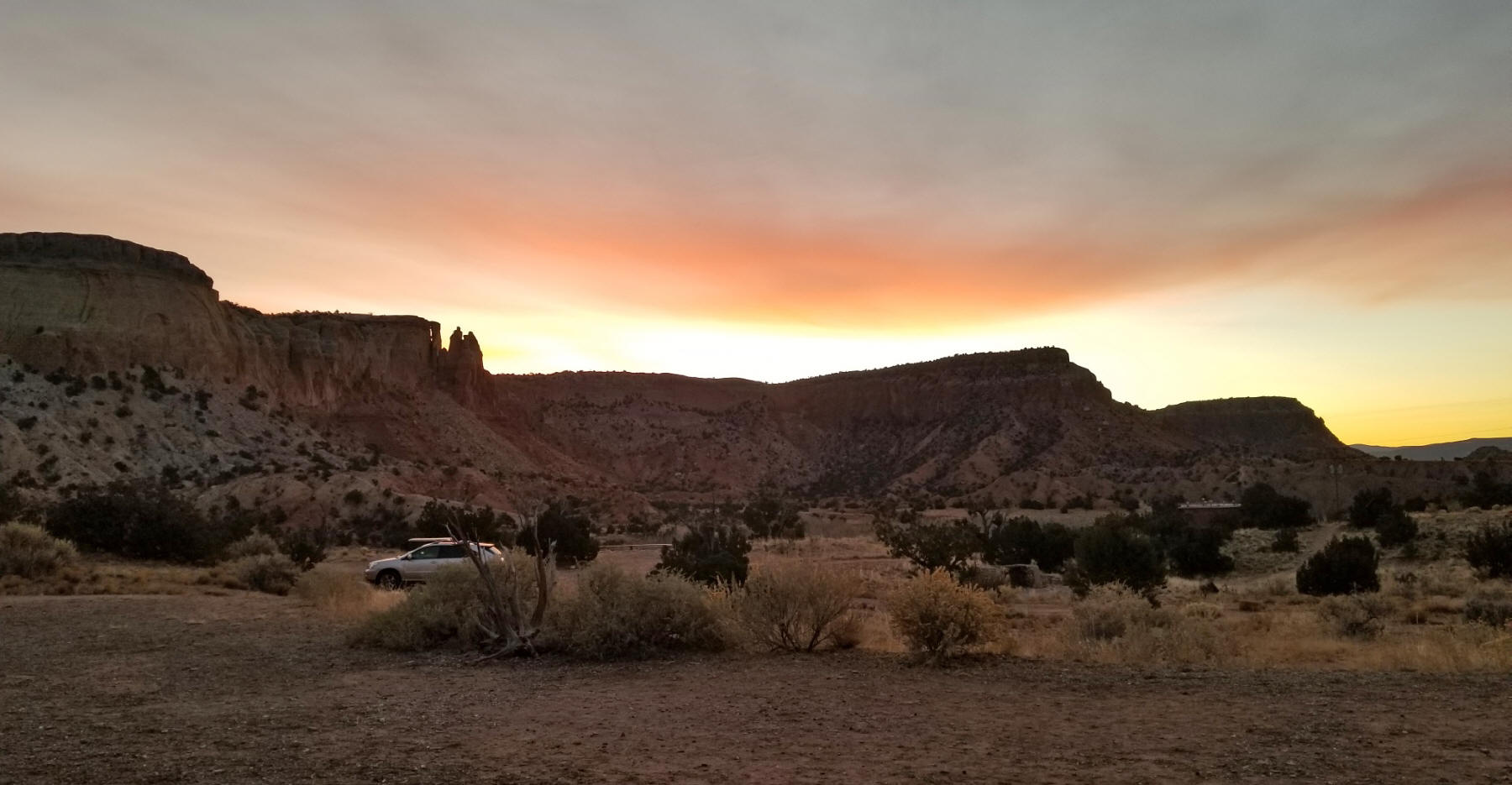|
The Most Interesting Town on the
Loneliest Road in America
Story and Photographs by Tom Straka
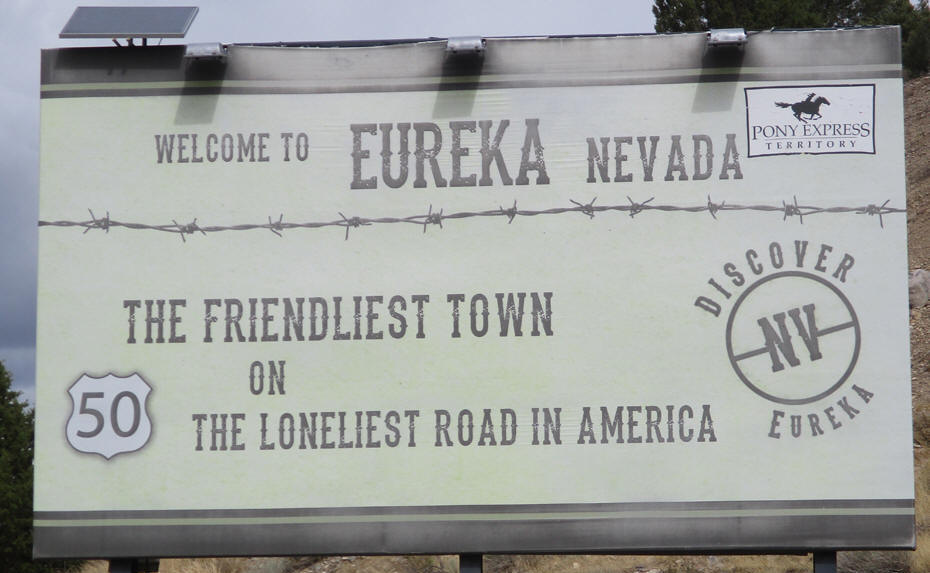
The July 1986 issue of Life magazine
had a theme of "America, the Wonderous," and included an article
on "America, the Most," highlighting, "superlatively speaking"
some of America's most surprising places. One was "the
loneliest road" in America, U.S. Highway 50, which runs
across Nevada from Lake Tahoe on the west to Great Basin
National Park on the east. The article warned the road was
desolate and drivers ought to have "survival skills," prompting
the state to publish a "survival
guide," and will issue a certificate to anyone who manages
to navigate it (by getting stamps on a "passport" at each town
on the route. The article claimed there were "no points of
interest" on the route, which was an exaggeration, as there are
plenty for the adventurous.
Arguably, the most interesting town on the
route is Eureka. As you'd expect in Nevada, it was established
as a
mining town. Nevada is best known for the huge Comstock Lode
silver mines near Virginia City, but Eureka was the state's
second richest silver-lead producer. The Comstock ores were rich
and required no smelting, but the central Nevada ores required
smelting, and Eureka would become one of the nation's largest
smelting towns, gaining the name "Pittsburgh
of the West" in the 1870s. It would have six smelting
companies operating sixteen furnaces, smelting the output of
fifty mines, which consumed about sixteen thousand bushels of
charcoal daily when operating at full capacity, and after a few
years there was no wood within fifty miles of Eureka.
Eureka's draw is mid-nineteenth century
mining history, and a significant part of that history relates
to the huge demand for charcoal fuel. Charcoal burning was an
immense subsidiary industry creating its own interesting
problems. One problem became a part of state history: the "Charcoal
Burners' War" or the "Italian War," named for the main
immigrant group comprising the charcoal burners. Charcoal was
the costliest element of the smelting process and the smelting
companies worked hard to keep the price of charcoal down,
resulting in agitation over the price of a bushel of charcoal.
In 1879 a charcoal strike resulted in the "massacre" of five
charcoal burners near town. The Eureka County Cemetery on the
hill behind the courthouse contains the graves of the charcoal
burners, including a memorial.
Most mining boomtowns don't survive; Eureka
is an exception, as what the locals call "The Friendliest Town
on the Loneliest Road." The town has preserved and restored the
mining history, creating a great opportunity for history buffs,
but, at the same time, plenty of hotel, restaurant, and shopping
opportunities. The best way to see the town is to follow the
self-guided
walking tour with 62 marked locations. Before you cringe at
62 locations, they concentrated in a few city blocks, quite
close together.
Raine's Market published a second version of the walking
tour. Some of my favorite locations are below, with descriptions
from the walking tours.
Some of My Favorites Mostly from the Walking Tour
The
Eureka Opera House and
Jackson House Hotel are next to each other. The opera house
was built in 1880, and the hotel was built in 1877 and rebuilt
in 1880 after a fire. The opera house is one of the
best-restored and usable opera houses in Nevada. It has a
capacity of over 300 and is one of two theaters in Nevada with a
horseshoe-shaped balcony. It still hosts music and community
events. The hotel has eight elegant Victorian bedrooms upstairs
and also operates as a restaurant and bar. It is supposedly
haunted (you might have watched Zak Bagans investigate the hotel
on Ghost Adventures).

The Eureka
Opera House with the adjacent Jackson House Hotel, across from
the Court House.
The
Eureka County Courthouse was built in 1879-1880 (being added
to already existing jail), has served as the courthouse since,
and sits in the middle of town. The edifice received a
structural facelift in 1995, but its interior still displays
some original furniture and walk-in vaults. The doors are
six-inch-thick iron and have lovely summer scenes painted on
them. A suspended gallery at the rear can seat 100. The
semi-circle witness box is distinctive because of its shape and
location in front of the judge's bench. The second-floor
courtroom is recognized as the best preserved in Nevada.

The Eureka County Courthouse, worth
exploring.
The
Eureka Sentinel Museum was built in 1879 from locally-fired
brick and housed the
Eureka Sentinel
Newspaper until 1960. The museum contains the original
pressroom and equipment from its newspaper days. Upstairs are
items representative of Eureka and there is a gift shop
downstairs. Many of the posters on the wall date to the 1880s.

The Eureka Sentinel Museum, more than a
newspaper museum, with plenty of city history.
The
Colonnade Hotel was originally built as a meeting house for
the Italian Benevolent Society in 1880. By 1890 it was vacant.
In the 1940s it was
converted into a boarding house and hotel. Today, it is one of
the premier
accommodations in Eureka.
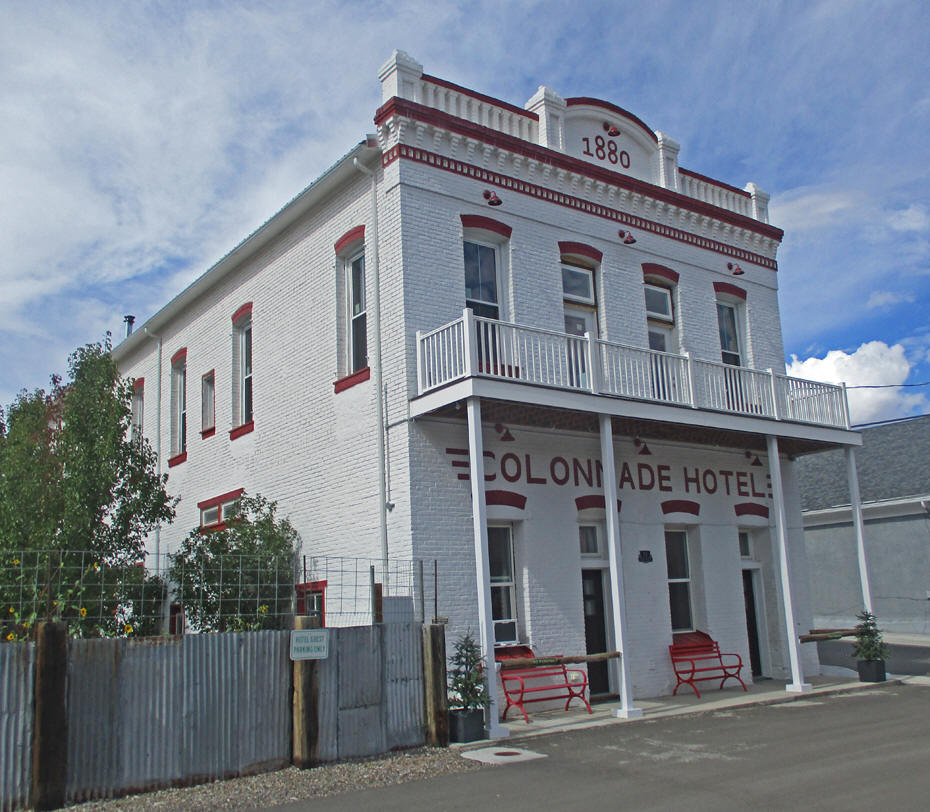
The Colonnade Hotel, accommodations in
the heart of things.
The
General Store. This brick building was built in 1882 as the
Ottawa Hotel to replace an earlier frame structure. For
many years, into the twenty-first century, it served as a
grocery and general store. In the 1920s it served as a Shell Oil
Company gas station and in the 1940s as a Union 76 gas station
in the 1940s.
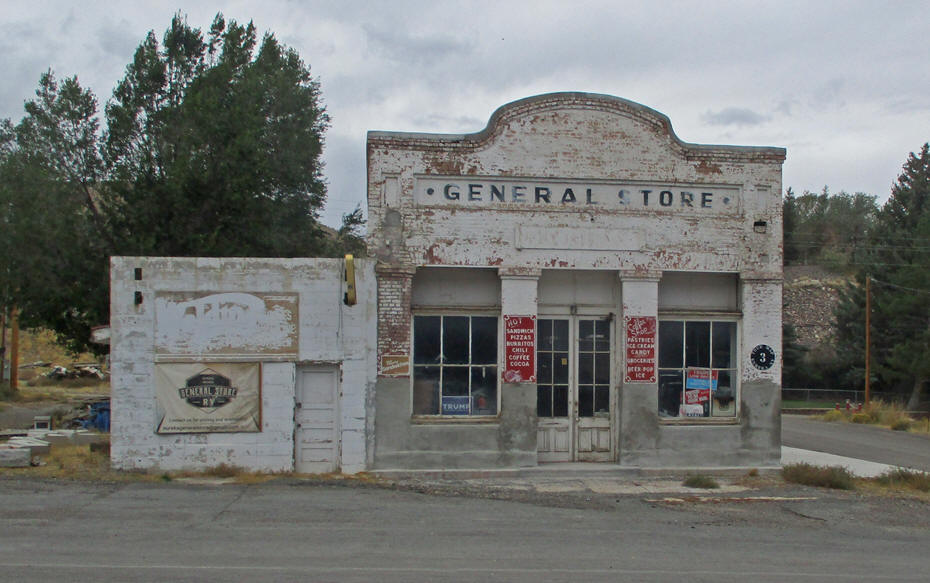
The General Store, there are plenty of
buildings in town with a ghost town flavor.
The
Tannehill Log Cabin, built in 1864, is believed to be the
first house in Eureka. It was built by the Tannehill brothers
who lived in it for about a year. It was built from limber pine
logs cut from the higher elevation forests from around Eureka.
It also served as Eureka's first store. Fires, floods, and the
ravages of time have spared the cabin, and local residents take
justifiable pride in the fact that they have been able to save
it.
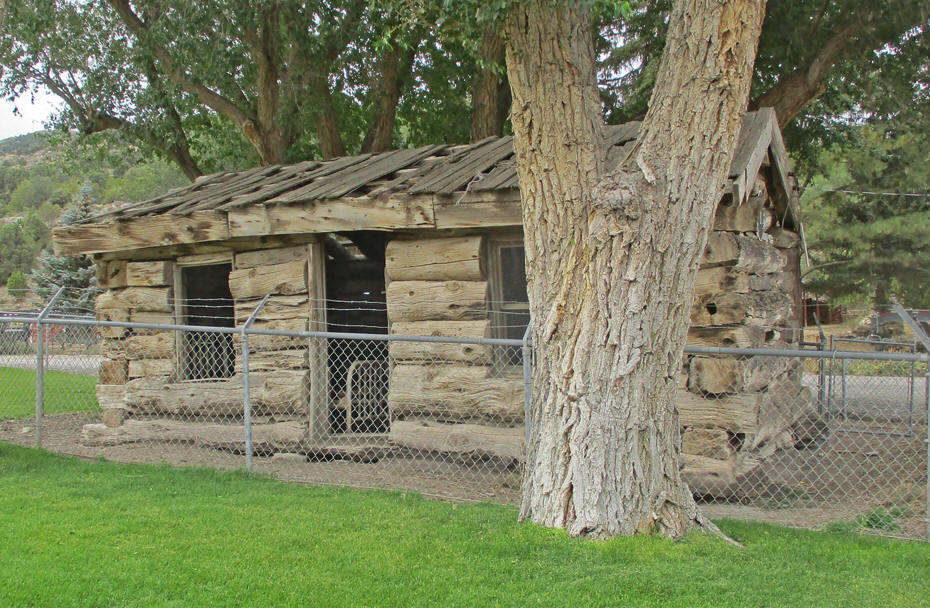
The Tannehill Log Cabin, probably the
first house in Eureka.
The
Eureka & Palisade
Train Car.
This crew car is the only piece of rolling stock left in
Eureka County from the
Eureka & Palisade Railroad. The narrow-gauge railroad began
in 1875 when Eureka businessmen formed a railroad company. It
was built to haul ore refined by Eureka's smelters 90 miles to
Palisade on the transcontinental railroad line. It also hauled
charcoal into Eureka from charcoal kilns along the line. The
crew car served as sleeping quarters for men working on the
railroad.

The Eureka & Palisade Railroad
connected Eureka to the outside world. As a mining town its
important task was to export refined ore and import charcoal to
fuel the smelters.
The
Eureka Inn and Saloon. Built in 1873, it is the oldest
operating business building in Eureka and is made of local
quarried volcanic tuff. A pharmacy and grocery have operated in
the building. A motel was on the southern side. Today it houses
Afterlife Antiques & Oddities. Beneath are sections of the
city's underground "cathedral" or catacomb tunnels.

The Eureka Inn and Saloon is the oldest
business building still operating in Eureka. There is access
below it to the city's underground tunnels.
Ghost Town Appearance. Eureka is well
preserved in most places, but a few areas are less well
preserved, and the opportunity exists to get images that appear
to be from ghost towns. These are scattered around town, mostly
at the edges. A couple of miles west of Eureka is the
Ruby Hill mining area, a real ghost town, with lots of
deserted buildings and abandoned mining equipment. Ruby Hill
Avenue leads uphill to the area and the road is paved the whole
way.
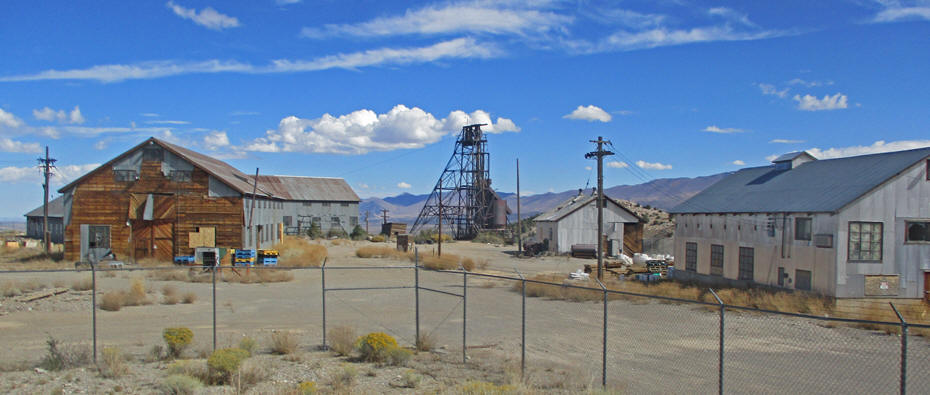
Above Eureka is the Ruby Hill mining
area, with an opportunity to see both deserted mining buildings
and equipment, but also some ghost town type buildings.
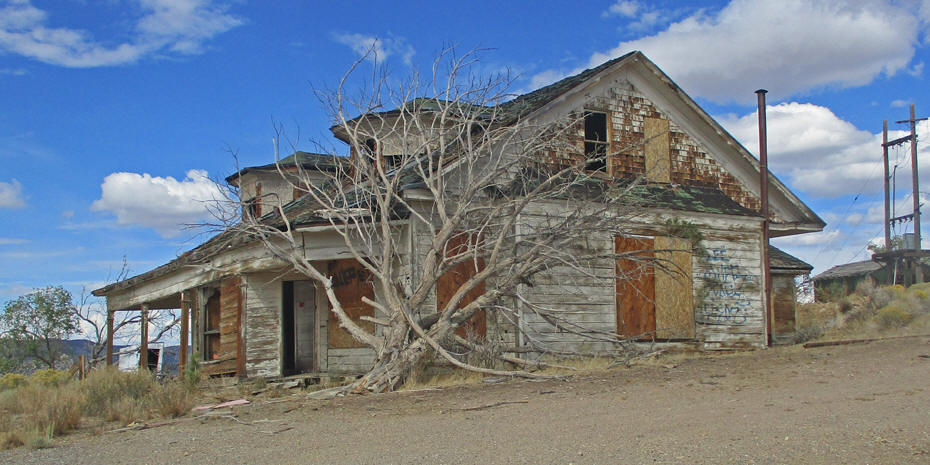
While there are plenty of ghost town
type houses and buildings in the town, Ruby Hill has some good
ones also.
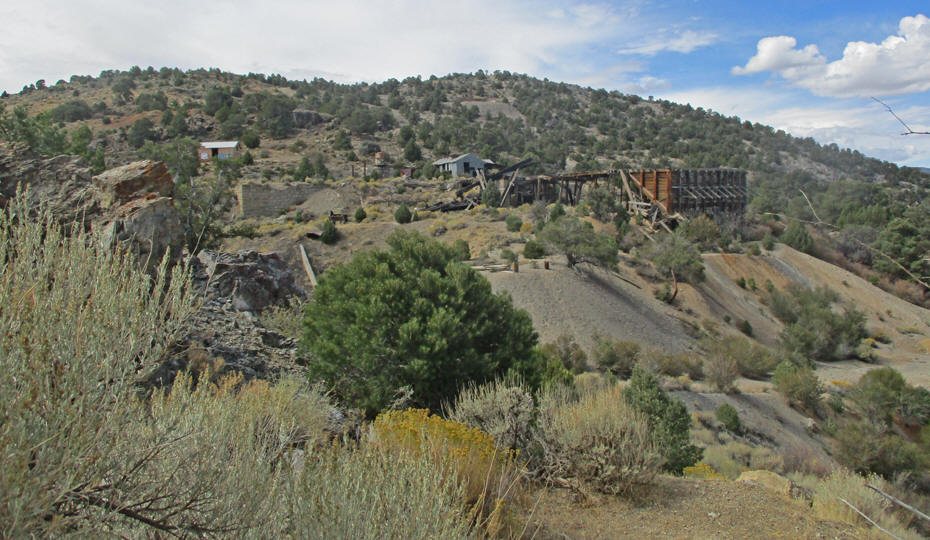
Ruby Hill has lots of interesting
leftover mining debris scattered around the area.
The
Slag Pile. While Riby Hill is the best option to see some
mining history, a bit of the smelting history of the town
remains on Main Street on the southern side of town. The Nevada
Historical
Marker in town notes that when smelter production ceased in
1891, their sites were "marked by the huge slag piles at both
ends of Main Street." Across from the General Store is the one
which is part of the walking tour. Slag is a glassy non-metallic
waste byproduct formed from the smelting process. This slag pile
is a small portion of waste from the Richmond Consolidated
smelting plant (1871) which was near this site. The ditch for
the smoke stack flume of the smelter can still be seen here.
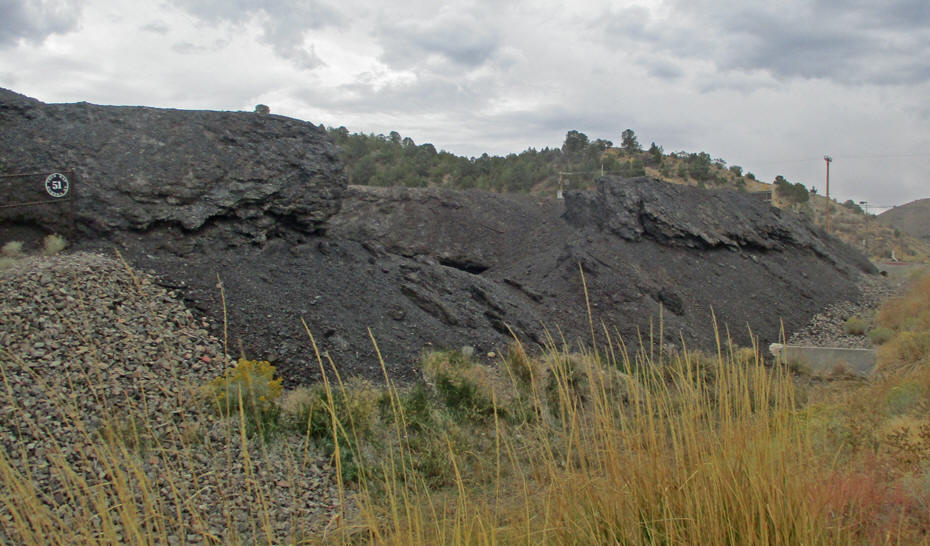
You don't have to go above town to Ruby
Hill to see mining artifacts. They are "hidden" all over town.
Both sides of town have huge slag piles left over from the
town's smelters.
Charcoal Burners in Town
As the smelters in Eureka used more and
more charcoal, the woodlands around Eureka became denuded of
trees. By 1879 charcoal burners had to move their operations
farther and farther from town, increasing their transportation
costs. The charcoal burners urgently needed a price increase for
their charcoal; smelter owners, faced with a declining market
for lead and silver, attempted to hold the price steady. After
contentious negotiation, the charcoal burners decided to strike
and stop charcoal production, which would close the smelters. A
sheriff's posse ended up killing five of the charcoal burners,
ending the "Charcoal Burners' War." There is still plenty of
evidence of that "war" in town.
The
Tognini and Company Building. This building was constructed
in 1877 by the Tognini Company, a Swiss-Italian company. It was
Eureka Billiard Hall and Saloon in its early years. It was also
the headquarters of one of Eureka's largest charcoal production
companies.

The Tognini and Company Building is
more hidden history. There has been much written about the
"Charcoal Burners' War" (a recent book on the War is
Charcoal and Blood by
Silvio Manno). Evidence of the charcoal industry is scattered
all over town.
The
Celso Tolli's Saloon. This building was constructed in the
1870s by Italian stone masons and later acquired by Celso Tolli,
a prosperous Italian entrepreneur. It is noteworthy as the
location of a large meeting on July 6, 1879, where hundreds of
Italian charcoal burners met and formed the Eureka Charcoal
Burners Protective Association, also known as the Carbonari. The
union was created to confront what the Carbonari considered low
and unfair charcoal price. The Carbonari went on strike on
August 9, 1879, leading to the "Charcoal Burners' War." This was
a central location for the activities that led up to the "war."

Celso Tolli's Saloon and the center of
"insurrection."
The
Diamond City Charcoal Kiln. Evidence of the
charcoal burners' activities lie in the hills surrounding
Eureka. The federal Bureau of Land Management (BLM) has
preserved one of the many remnants of charcoal kilns about 20
miles northeast of Eureka.
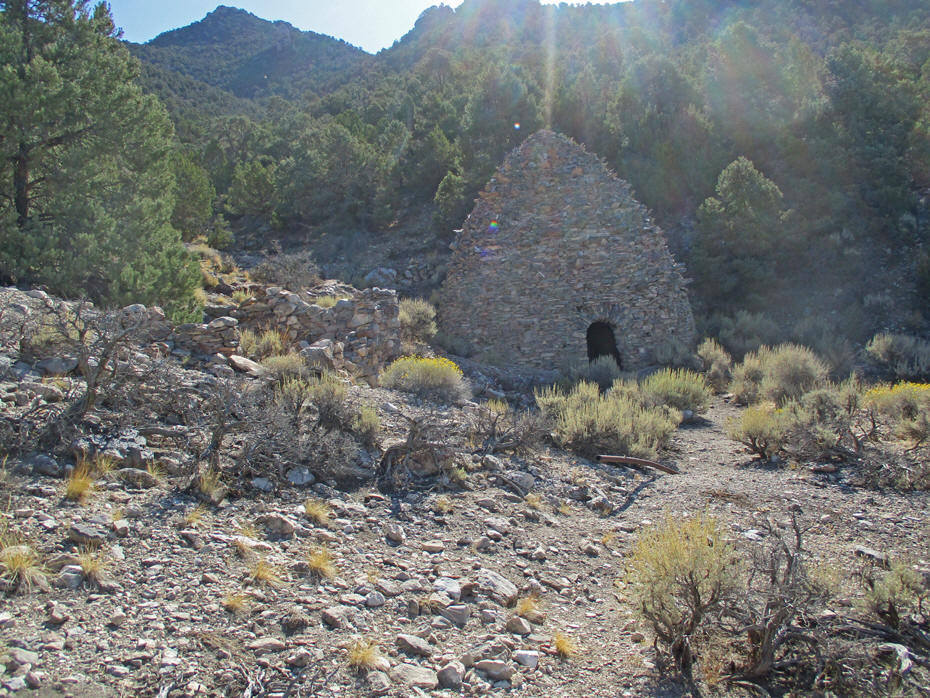
A charcoal kiln north of Eureka. More
evidence of the "Charcoal Burners' War. It is a beautiful site
to visit, and the kiln is fully intact, but you'll need a
high-clearance SUV to visit it. The BLM sign near the charcoal
kiln says: "Built around 1869, this structure produced charcoal
for the thirteen smelters around Eureka. By 1891 the entire area
visible from tis location was denuded of trees, as five acres of
timber were required for each firing. One charge produced 1400
bushels of charcoal, for which Swiss-Italian workers received 27¢
per bushel."
The Eureka County Cemetery contains a memorial to the five
charcoal burners who lost their lives in the "war." The
gravesite is downhill and to the left from the gate.
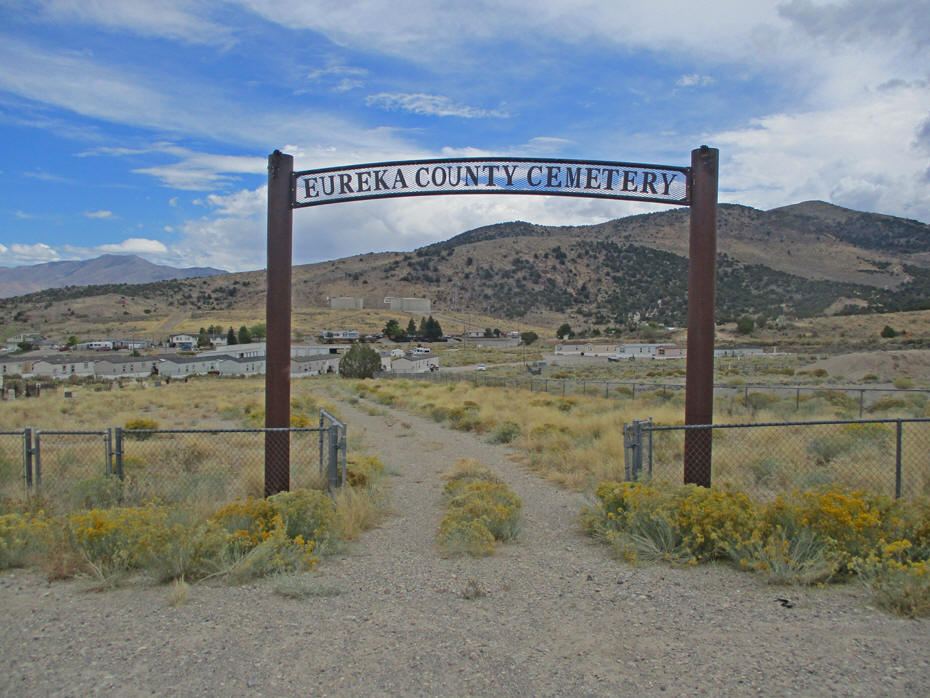
Eureka has several cemeteries and all of them have history in
them.
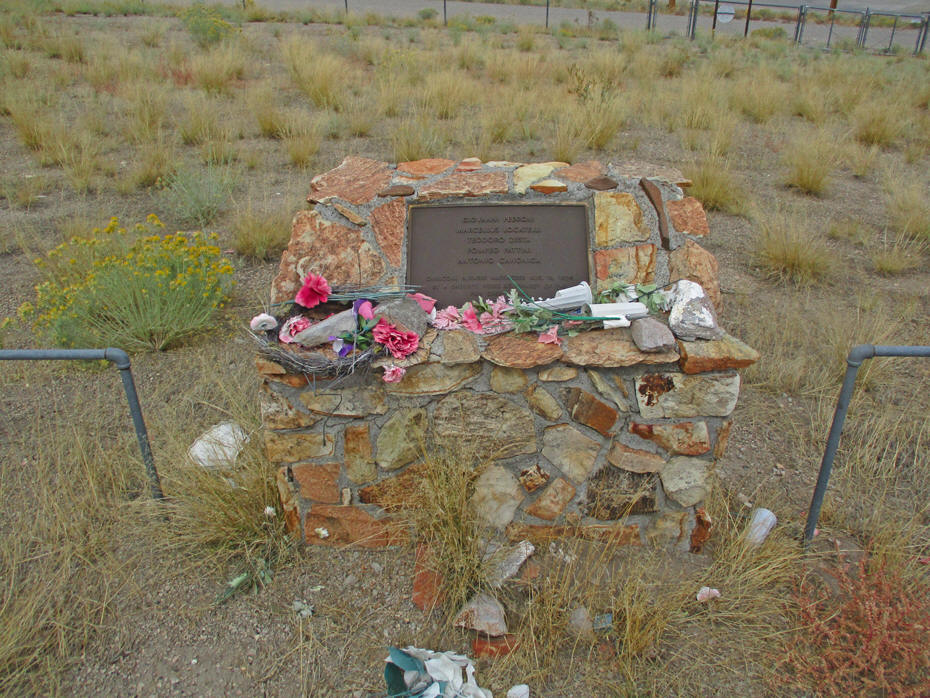
Memorial and grave marker for the five slain charcoal burners.
The Walking Tour hits all of the major buildings and mining
history. But not listed on the walking tour are dozens of
artifacts simply sprinkled around town. Most are from the mining
activity. They add to the living history aspect of the walking
tour.

Lots of interesting things are not on the official walking tour.
Author/Photographer. Tom Straka is
an emeritus professor of forestry at Clemson University in South
Carolina. He has an interest in history, forestry and natural
resources, natural history, and the American West.
Public
Disclosure Please Read FTC has a law
requiring web sites to let their readers know if any of the
stories are 'sponsored' or compensated. We also are to
let readers know if any of our links are ads. Most are not.
They are just a way to direct you to more information
about the article where the link is placed. We have several ads
on our pages. They are clearly marked as ads. I think
readers are smart enough to know an ad when they see one but to
obey the letter of the law, I am putting this statement here to
make sure everyone understands. American Roads and Global
Highways may contain affiliate links or ads. Further, as their
bios show, most of the feature writers are professional travel
writers. As such we are frequently invited on press trips, also
called fam trips. On these trips most of our lodging, dining,
admissions fees and often plane fare are covered by the city or
firm hosting the trip. It is an opportunity to visit places we
might not otherwise be able to visit. However, no one tells us
what to write about those places. All opinions are 100% those
of the author of that feature column.
| 
